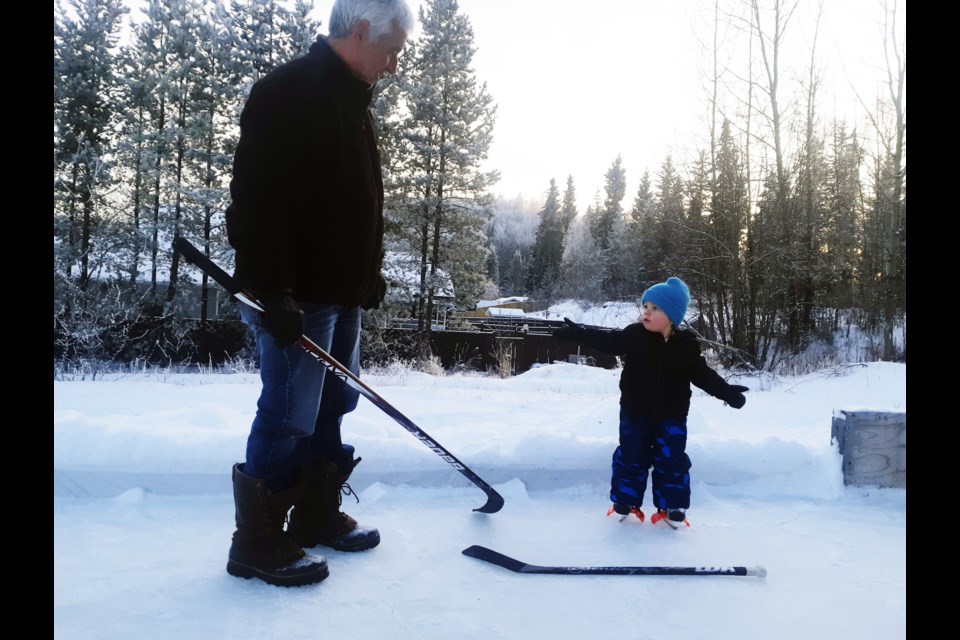Long before her brother Brandon made it to hockey’s top rung as an NHL defenceman, Jessica Manning paid her dues fetching loose pucks for him on the outdoor rink where they both learned to skate.
Her four-years-older brother used to pay her to gather up the pucks so he could practice his shot. She was even brave enough to stand in the crease as a scrimmage goalie to try to keep him from scoring. Until that time, when she was about seven, he rifled a shot that hit her square on the nose.
“It was an accident, but he did shoot at my nose,” Jessica said. “He didn’t break it but I thought it was broken.
“I still came back. I’d get paid 10 cents a bucket to pick up all the pucks he shot into the net. He’d shoot 50 of them and I’d go pick them up. If it wasn’t for my puck picking-up skills (and the outdoor rink) he might not have made it to the NHL.”
Backyard rinks have long been a Manning family tradition. Before he had kids and grandkids of his own, Leroy Manning skated on sheets of outdoor ice his dad Leo, a former Prince George Mohawk, used to flood for him in their Hart Highlands neighbourhood. Now that he’s retired as a Prince George firefighter, Leroy has plenty of time to spend teaching his just-turned two-year-old grandson Connor how to skate on the rink he’s built for him.
Leroy saw how much Brandon benefited from playing on an outdoor rink. From the time he was five or six he was able to practice his skating and stickhandling skills with more frequency and longer duration than what was possible practicing indoors with his minor hockey teams.
“If the kids are playing two hours a day with their buddies, they’re touching the puck the entire time,” said Leroy. “If I flooded it at night he’d go on it before school sometimes, he liked it.”
The extra ice time gave Brandon confidence because he could skate and handle the puck better than most of his peers, which led to a pro hockey career in Philadelphia, Chicago, Edmonton and now the German Elite League.
Leroy is hoping his grandson Connor will take a similar shine to the game and, so far, it’s working. Even when it got cold a couple weeks before Christmas, he still wanted to be out chasing the puck balancing on skates with plastic training attachments to keep him from falling.
“We go out almost every day, every afternoon,” said Connor’s mom Katlyn, Leroy’s oldest daughter. “We all live in the same neighbourhood and papa stops by for an hour or so and it works out well. Almost every day there’s kids here using it.”
Key to starting a rink is to have a flat surface to begin with, so a tennis court or parking lot is ideal. Manning got permission from local developer Craig Church to build his rink on an empty lot on McTavish Road that’s right next door to where Connor lives with his parents, Kaitlyn and Aaron Starlund. Church brought in a piece of heavy equipment to flatten the lot and the Mannings used donated wood to build boards a metre-high wall at either end. Another donor provided lights, which are hooked up to a timer, powered by a cord they plug into the house
“If it’s not flat you’re flooding with a lot of water,” said Leroy. “Where I used to do it there would be eight inches (of ice) at one end and two inches at the other. Eventually it evens out, but that’s lots of unnecessary flooding.”
He put tarps down under the entire surface before he started flooding. It’s not a necessity but it helps to have a layer of plastic to confine the water and freeze the ground solid, especially early in the season when the temperature is not much below the freezing point.
There’s a fire hydrant nearby close to the street and being a former firefighter, Leroy knew what to do to operate it. He used it few times to get the base layer down, until the valve stem of the hydrant broke.
“Better that it happened with me here than when there’s a house fire,” said Leroy.
On really cold days, below -20C, smooth flooding becomes more of a challenge because the water freezes before it’s had a chance to level itself. Once there’s a layer of ice down, hot water works best to apply subsequent layers because the water binds better to the existing ice, so the Mannings hook up a hose to the hot water tap of their house and run to the rink. The garden hose is connected to a four-foot length of pipe that sprays the warm water as it is dragged over the rink to allow better penetration into the cracks.
Don’t put too much water on with each flood. The likely result is you’ll get a thin layer of ice crusting over pockets of water that don’t freeze and that will leave holes in the ice surface.
The City of Prince George website has a map of the community ice rinks.



.png;w=120;h=80;mode=crop)